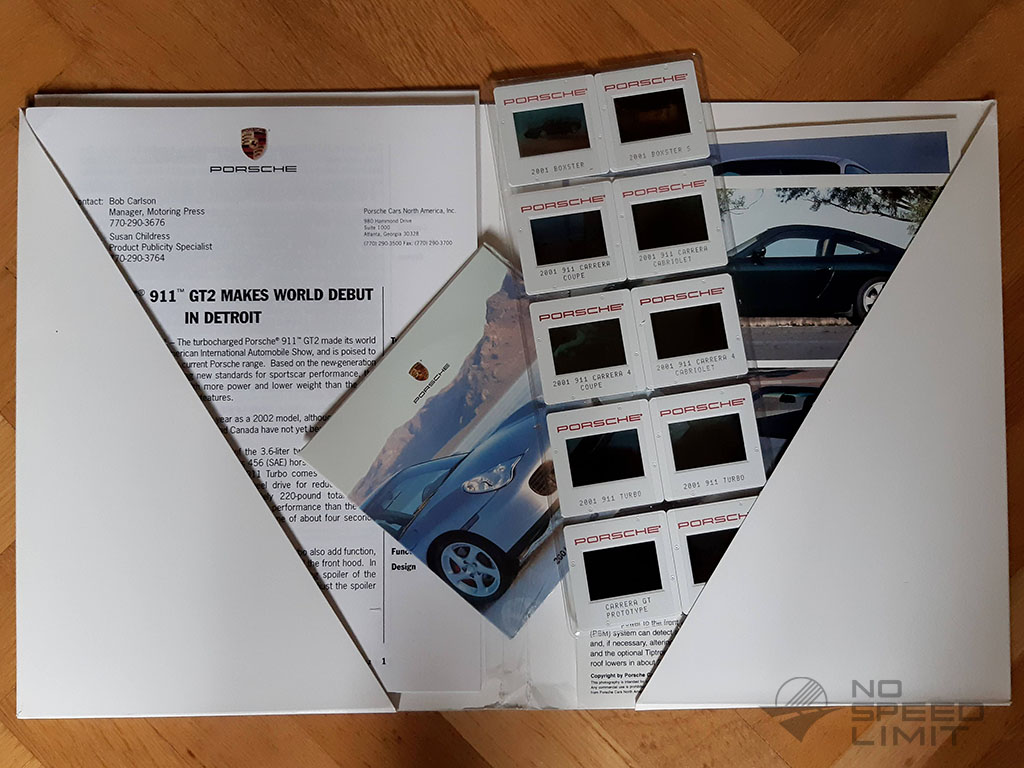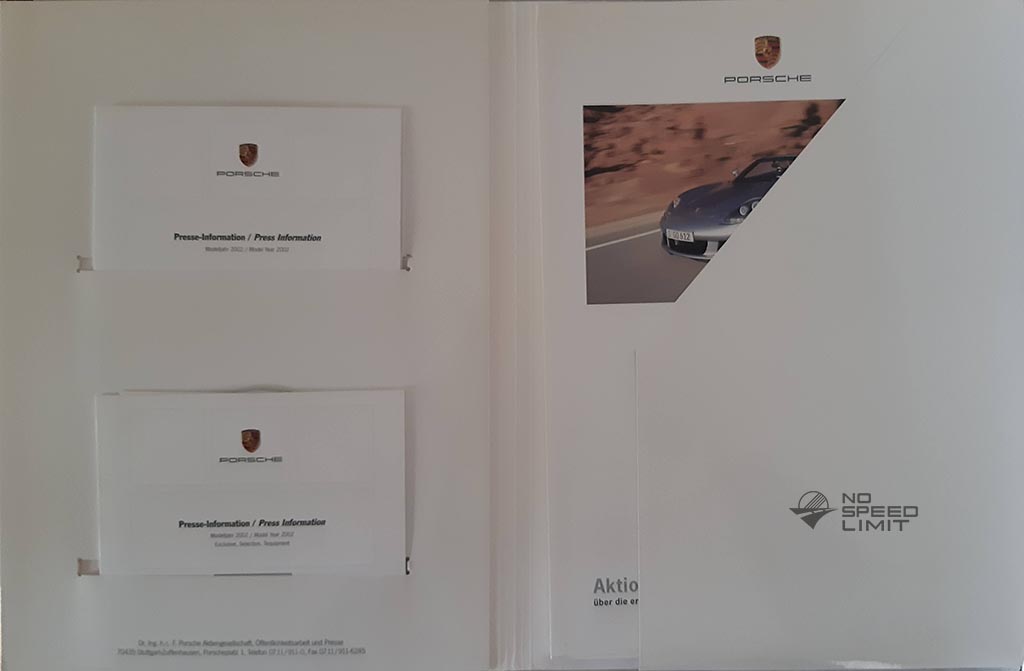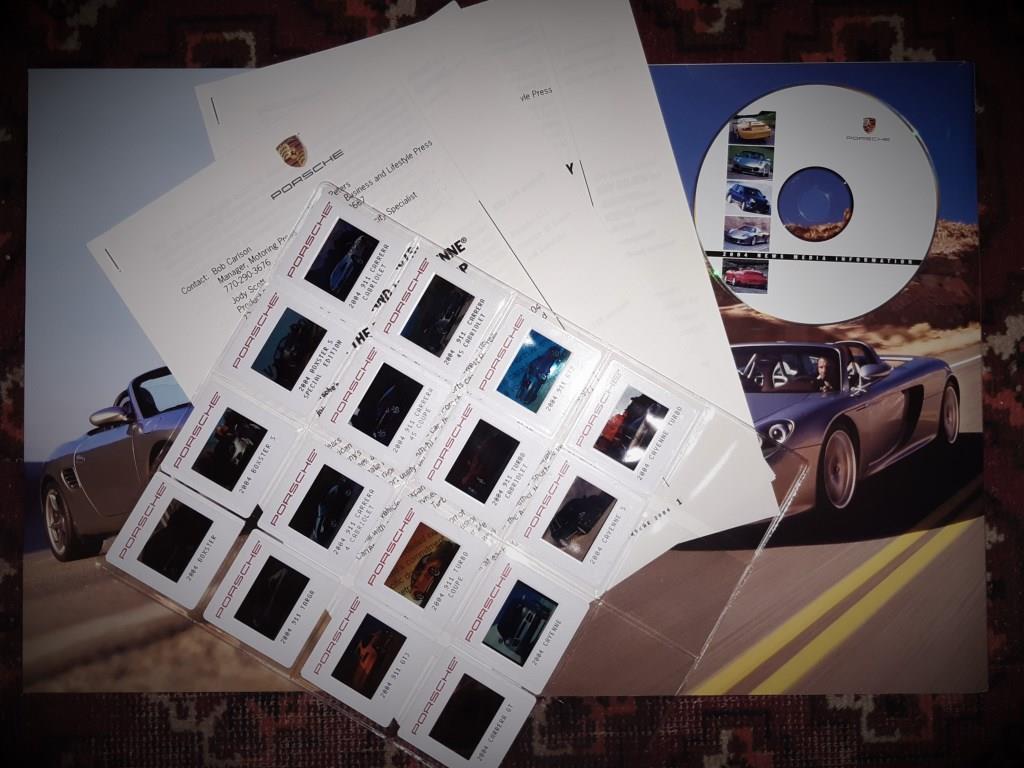
Porsche Press kit 2001

The 911 GT2 made its world debut early this year at the Detroit Motor Show. Featuring rearwheel drive, it is the most powerful contender in the 911 model series with its 3.6-litre horizontally-opposed power unit boosted by two turbochargers to develop maximum output of 340 kW or 462 bhp at 5700 rpm. With its power-to-weight ratio of 4.23 kilos per kilowatt or just 3.11 kilos per horsepower, the GT2 accelerates from 0-100 km/h in a mere 4.1 seconds. The 200 km/h-mark, in turn, comes from a standstill in just 12.9 seconds. Top speed, finally, is 315 km/h or 195 mph.
The 911 Turbo has a top speed of 305 km/h or 189 mph and accelerates to 100 km/h in 4.2 seconds. Its 3.6-litre power unit also sets new standards, the six cylinders boosted by two exhaust gas turbochargers with intercoolers developing maximum output of 309 kW (420 bhp) at 6000 rpm. Maximum torque of no less than 560 Newton metres or 413 lb-ft is available from just 2700 rpm. The new 911 Turbo expresses its outstanding position not only through excellent engine and performance data, but also through a very wide range of standard features
The 911 models with naturally aspirated engines have come slightly closer to the turbocharged versions this year. All Carreras now have a restyled front area and the 911 Turbo’s headlamp design for an even more powerful, dynamic appearance. The flat-six ‘Boxer’ engine with capacity increased to 3.6 liters and a power output of 235 kW (320 bhp) at 6,800 rpm is located behind the rear axle; it accelerates the six-speed manual-gearbox Coupe from 0 to 100 km/h in five seconds. Peak torque is now 370 Nm at 4,250 rpm. Despite the 3.6-liter engine’s increased performance and the higher, flatter torque curve over the entire engine speed range, it only consumes 11.1 liters of fuel, a reduction of approximately six percent according to standard EU test method, mainly due to VarioCam Plus, which combines variable camshaft control with valve lift adjustment on the inlet side.
The cabriolet, which has a rigid glass, heated rear window, is based on the 911 Carrera or 911 Carrera 4. The engine itself is identical on both the rear-wheel and four-wheel versions of the cabriolet. In developing the 911, Porsche's engineers focused from the start also on the open-air model, making the bodyshell particularly strong and torsionally rigid. Roof operation is electrohydraulic, allowing the driver to open or close the roof fully automatically at the touch of a button within just 20 seconds. The range of standard features on the cabriolet, in turn, is fundamentally the same as on the Carrera coupé or, respectively, Carrera 4. An additional feature with the cabriolet, of course, is the aluminium hardtop weighing a mere 33 kg that two persons can easily lift on and off.
Whether as a coupé or cabriolet, with six-speed manual gearbox or five-speed Tiptronic S, the Carrera 4 offers the aficionado of the 911 a wide range of choice and variations. Permanent four-wheel drive with a variable supply of power to the front wheels is ensured by a viscous coupling. The Carrera 4 is also equipped with Porsche Stability Management (PSM) as standard. With this system, the existing units already controlling the car's longitudinal dynamics such as the anti-lock brake system, anti-spin control and the automatic brake differential are further enhanced by lateral control: Applying the brakes individually as required and influencing engine power automatically, PSM is able to control and maintain driving stability when cornering. The engine is the latest version of Porsche's flat six with VarioCam Plus, developing 235 kW (320 bhp).
In this business year Porsche is presenting the new 911 Carrera 4S, which is very similar to the 911 Turbo in appearance. The rear part of the body is 65 millimeters wider than on the Carrera models, and the wheel housings contain 18-inch alloy wheels in Turbo styling that provide ample traction. The distinguishing features between this model and the Turbo mainly become obvious at the rear: A Carrera spoiler is used instead of the extending, divided wing, and has a red light strip forming a visual link between the two rear lights. The 911 Carrera 4S’s suspension, which has been lowered by ten millimeters, is based on the 911 Turbo; including the brake system, the power train mountings and a front-axle pivot bearing that has been optimized for brake ventilation. The 911 Carrera 4S has a 235 kW (320 bhp) 3.6-liter flat-twin engine and four-wheel drive as a standard.
After a break of more than three years, Porsche has revived the Targa tradition and now offers the 911 once again with a large, retractable glass roof panel. At the push of a button, the new 911 Targa’s glass roof can be slid backwards by up to half a meter, for a maximum roof opening area of 0.45 square meters. Further Targa highlights include the hinged rear window, which is supported on two gas springs. It provides convenient access for loading suitcases, bags or other luggage into the rear compartment, which has a maximum capacity of 230 liters. The rear window can either be unlocked at a rocker switch the sill next to the driver’s seat or by using the remote control. Like the other Carrera models, the Targa has the new 235 kW (320 bhp) 3.6-liter flat-six engine; its top speed is 285 km/h.
Turning the Boxster into an entire model series, Porsche has added the Boxster S to the range, thus offering the enthusiastic driver an additional model with a standard of performance and equipment far superior to the “basic” version. The Boxster S develops ample power from 3.2 litres capacity, the increase in engine size guaranteeing not only a muscular 185 kW (252 bhp) at 6250 rpm, but also torque boosted to 305 Newton metres or 225 lb-ft at 4500 rpm. Acceleration from 0-100 km/h with the standard six-speed manual gearbox takes a mere 5.9 seconds, top speed is 260 km/h or 161 mph. Cross-drilled brake discs in the same dimensions as on the 911 Carrera ensure excellent deceleration. The wide range of standard features, finally, includes 17-inch light-alloy wheels and an alarm system with interior surveillance, while special features such as titanium-coloured air scoops at the front, red-painted brake callipers and twin tailpipes distinguish the Boxster S from its “smaller” brother.
Porsche’s mid-engined roadster has a 2.7-litre power unit. Maximum output from its six cylinders is 162 kW (220 bhp) at 6400 rpm. Acceleration from 0-100 km/h takes 6.6 seconds with the standard five-speed manual gearbox. Top speed is 250 km/h (155 mph). Inside, the Boxster excels in particular through the use of high-quality materials, the seats being finished in ultra-fine Alcantara. The synthetic components around the instrument panel, the centre console, the seats and door panels are all treated with black soft paint. Leather, finally, is used generously on the steering wheel rim, shift lever, handbrake lever and door closing handles. Like the Boxster S, the Boxster comes with a lined soft top and a sporting three-spoke steering wheel with coloured Porsche logo. As an option both Porsche cars are available with Porsche Stability Management (PSM).

Porsche Press kit 2001

Porsche Press kit 2004 - USA

Porsche Press kit

Porsche Literature

Our Porsche Cars